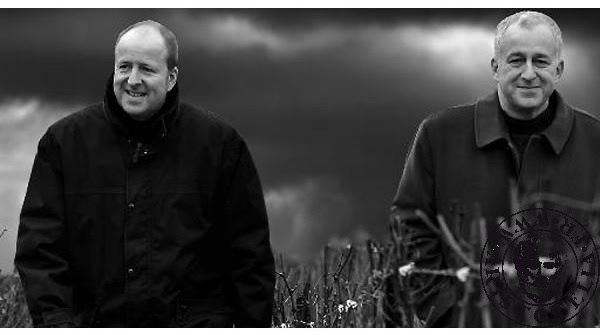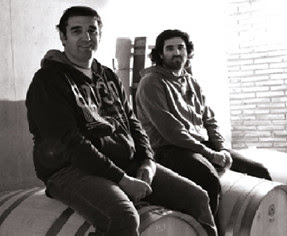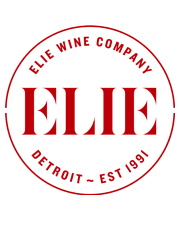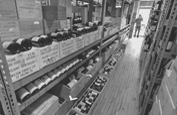The Champagne Society – February 2018 Selection: Champagne Jacquesson
Champagne Jacquesson “Cuvée 740” (Extra Brut)
Price for The Champagne Society members: $67 (regular price $79)
We take pride in the diversity of the wines that we offer to The Champagne Society, so it is a matter of no small consequence that we decided to revisit ChampagneJacquesson’s 700 series with the latest release.
Although technically a Champagne house, brothers Laurent and Jean-Hervé Chiquet operate Champagne Jacquesson m
 According to the Chiquet’s, “Cuvée 740” is quite possibly the finest of the 700 series yet to be produced. The primary portion of the blend is from the 2012 Vintage with fruit harvested in the Grands Crus of Aÿ & Avize, and the Premiers Crus of Dizy, Hautvillers and Oiry. The Cuvée is completed with several reserve wines from previous 700 Cuvées to make up only about 20% of the blend.
According to the Chiquet’s, “Cuvée 740” is quite possibly the finest of the 700 series yet to be produced. The primary portion of the blend is from the 2012 Vintage with fruit harvested in the Grands Crus of Aÿ & Avize, and the Premiers Crus of Dizy, Hautvillers and Oiry. The Cuvée is completed with several reserve wines from previous 700 Cuvées to make up only about 20% of the blend.
A long and frigid winter coupled with a spring and early summer that were exceedingly wet, the 2012 vintage started out quite challenging. Fortunately, a superb end to the growing season produced a small crop of remarkable quality for this esteemed house. The result is a Champagne with a tremendous amount of energy and sap. Aromatics of lemon verbena, crisp green apple, and a baguette just out of the oven overlay a palate that is simultaneously bracing and full with an interminable mineral finish. “Cuvée 740” is a Champagne with a rock solid core that will provide a great few glasses of wine from now until the mid-21st Century.

- - -
Posted on 2018.02.01 in France, The Champagne Society, Champagne | Read more...
Saturday Sips: New-School Rioja – the Single Vineyard Wines of Artuke
Modern Rioja’s storied history began in the mid-1800s when local winemakers adopted the methods of Bordeaux and began aging their wines in wooden casks. Since then, the region has tended to spotlight the amount of time the wine spent in oak barrels, effectively putting a supporting actor in the leading role. But as Nobel Prize winning poet Bob Dylan often says, the times they are a-changin’. In June of 2017 The Consejo Regulador in Rioja announced the introduction of a “Singular Vineyard” designation to be known as Viñedos Singulares. Soon the quality of Rioja wine can be linked to a specific terroir.
 In practice, these “Singular Vineyards” are nothing new for brothers Arturo and Kike de Miguel Blanco, third generation viticulturalists that produce wine for Artuke Bodegas y Viñedos. These two young men have completely refocused the family winery to cultivate small vineyard plots in and around their village of Abalos in the high elevation foothills of the Cantabrian Mountains. Yet they currently have no plans to adopt the new labeling to their own wines, believing that the laws were thrown together too hastily, without enough study of the soils and history of the land.
In practice, these “Singular Vineyards” are nothing new for brothers Arturo and Kike de Miguel Blanco, third generation viticulturalists that produce wine for Artuke Bodegas y Viñedos. These two young men have completely refocused the family winery to cultivate small vineyard plots in and around their village of Abalos in the high elevation foothills of the Cantabrian Mountains. Yet they currently have no plans to adopt the new labeling to their own wines, believing that the laws were thrown together too hastily, without enough study of the soils and history of the land.
Although the brothers are already working somewhat outside the established regulations of Rioja, their wines clearly reveal the characteristics of the Alavesa sub-zone, the northernmost and smallest of the three Rioja sub-zones, where the cooling influence of the Atlantic Ocean meets the warmer interior. This unique climate has the effect of ripening Tempranillo grapes with slightly thinner skins, yielding wines with superb fruit and freshness.
 “Finca de los Locos” (Rioja, 2015)
“Finca de los Locos” (Rioja, 2015)
Special 6-Pack Price: $194 (~$32/bottle)
Arturo and Kike’s grandfather was regarded as crazy (loco) for purchasing this single vineyard located on a high terrace around 1,600 feet in elevation overlooking the Ebro river in Baños de Ebro. The plot consists of nearly 40-year-old vines growing in a sandy, gritty soil over a chalky limestone subsoil. A blend of 80% Tempranillo and 20% Graciano that is aged for 13 months in both 500 and 3500 liter French oak barrels, this wine shows it’s Atlantic climate mainly on the palate as ripe red fruit immediately turns crunchy to lead into a lengthy mineral finish. Aromatically complex, a noseful is rewarded with plums, minty herbs, dark chocolate, baked earth, and cherry blossoms. You could do worse things than pairing “Finca de los Locos” with some fatty red lamb chops.
 “La Condenada” (Rioja, 2015)
“La Condenada” (Rioja, 2015)
Special 6-Pack Price: $405 (~$67/bottle) SOLD OUT
From a single plot of sandy soil with a substrata of sandstone planted in 1920. The Blanco family purchased this nearly abandoned vineyard in 2012 and began to tend the majority of Tempranillo along with around 20% of other grapes, both red and white, including Graciano and Calagrano. All grapes are harvested and fermented together, and then matured in a 600-liter oak barrel for 14 months. The result is a wine that is concentrated and silky and brimming with a potpourri of heady aromatics.
More wines from Artuke Bodegas y Viñedos
 “Artuke” (Rioja, 2016)
“Artuke” (Rioja, 2016)
Special 6-Pack Price: $86 (~$14/bottle) SOLD OUT
“Artuke” is made with the carbonic maceration method, a wine-making technique used to enhance aromatics and produce light, fresh, fruity wines preferred by Basques in the northern sub-zone of Alavesa. It is a blend of mainly Tempranillo grapes, fermented and aged in cement and stainless steel. Candied red berries follow behind a burst of violets and cinnamon on the nose. There is minimal tannic structure which allows this red wine to take a relatively deep chill and also makes it quite a versatile pairing with food: tuna, pretty much anything made with zucchini, fried chicken, gooey cheese sandwiches, pizza, etc…
 “Pies Negros” (Rioja, 2015)
“Pies Negros” (Rioja, 2015)
Special 6-Pack Price: $130 (~$22/bottle)
A blend of 90% Tempranillo and 10% Graciano from vines as old as 95 years, Pies Negros means Black Feet, a reference to the archaic method of crushing the grapes using one’s feet – a technique that the brothers are determined to use to this day, as they believe the gentle crushing helps to maintain the purity of the fruit. After fermentation, the wine is aged for 14 months in a combination of new and older 225 liter oak barrels, resulting in a wine that’s full of mature, dark red fruits and a touch of spice with a firm finish.
- - -
Posted on 2018.01.31 in Saturday Sips Wines, Spain DO, Rioja DOC | Read more...
A “Marriage” of Great Terroirs in the South of France
Domaine d’Aupilhac “La Boda” (Montpeyroux Languedoc 2014)
Special Price: $243/6-pack (~$41/bottle)
The 44 acre lieu-dit known as Aupilhac is a renowned, fully biodynamic certified property located in the enclave of Montpeyroux just across the river Hérault from Daumas Gassac and Grange des Pères. Though five generations have farmed these choice vineyards, it was Sylvain Fadat that brought the estate its acclaim. Not one to shy away from hard work, Sylvain cultivates vines on steep, extremely rocky terrain, and has even terraced much of the land himself – an enormous financial investment and back-breaking work but necessary in this case to reveal a great terroir.
 Sylvain believes that effort in the vineyard has the most influence on the quality of his wine. He coaxes old vines to root deep into soils of limestone, clay, scree, and blue marl. The grapes are harvested by hand and only indigenous yeasts are used. The wines are bottled unfiltered in accordance with the lunar cycle and optimal atmospheric pressure. It’s the meticulous attention to each and every one of the small details that result in wines of great expression.
Sylvain believes that effort in the vineyard has the most influence on the quality of his wine. He coaxes old vines to root deep into soils of limestone, clay, scree, and blue marl. The grapes are harvested by hand and only indigenous yeasts are used. The wines are bottled unfiltered in accordance with the lunar cycle and optimal atmospheric pressure. It’s the meticulous attention to each and every one of the small details that result in wines of great expression.
The cuvée “La Boda” gets its name from the Spanish word for marriage. The blend is a union of terroirs: 45% Syrah comes from the north-west facing vineyard of “Les Cocalières” that is situated at an altitude of some 1,150 feet and rich in prehistoric oyster fossil deposits, which lend an incredible length and minerality to the wine. The remaining 45% Mourvèdre and 10% Carignan come from the Aupilhac vineyards on south-west facing hillside terraces.
Long maceration with regular pump-overs and aging for 24 months in 300-liter barrels helps create this deep, rich, and vibrant wine. It practically fills the room with its fragrant notes of ripe blueberries and blackberries, garden herbs and crushed stone. A sip is simultaneously ripe and electric, filled with pure fruit balanced by a marathon finish. While the wine has the structure to develop in the cellar it is an absolute stunning drink right now.
More wines from Domaine d’Aupilhac

Domaine d’Aupilhac “Lou Maset” (Coteaux du Languedoc 2016) Red
Special Price: $97/6-pack (~$16/bottle)
It stands to reason that some of the best inexpensive wines are the ones made by winemakers who know how to make great wines. With all the characteristics of a quality Languedoc wine “Lou Maset” is made in a style that emphasizes its fresh fruit. It’s an ideal bottle for those busy weeknights when dinner consists of a quick cheese platter or even pizza. A blend of 40% Grenache, 40% Cinsault, 10% Mourvèdre, and 10% Carignan, vinification is done traditionally in stainless steel vats and the wine is aged a further six months in neutral barrels.
 Domaine d’Aupilhac “Le Carignan” (Mont Baudile IGP 2015) Red
Domaine d’Aupilhac “Le Carignan” (Mont Baudile IGP 2015) Red
Special Price: $200/6-pack (~$33/bottle)
Formerly the most widely planted grape in France, and quite often overproduced, Carignan doesn’t have the best reputation. Generally, it’s high levels of tannins and acidity work best as a small proportion of a blend. But gifted vigneron like Sylvain Fadat know that very old Carignan vines that are managed artfully are capable of producing the concentrated ripe fruit needed for a wine of great significance. From the beginning, Sylvain has tirelessly defended Carignan as the “origin, history, and essence of the region.” So much so that he has declassified “Le Carignan” from the Languedoc Montpeyroux appellation (which requires no grape variety be more than 70% of a blend) to the more general Mont Baudile IGP, just so that he could bottle this superb fruit on its own.
The result is a wine of concentrated dark fruit that’s never heavy on the palate, with ripe tannins on the finish and a final twist of freshness at the close. Above the elegant textures are a grocery basket of sumptuous aromatics: blueberry and red currants, moist earth, and the Languedoc shrubland (garrigue) that comes across as just the slightest hint of rosemary. While drinking beautifully now, this is a wine of longevity – reports have the 1989 vintage (Sylvain’s first) still drinking nicely.
- - -
Posted on 2018.01.24 in Saturday Sips Wines, France, Languedoc-Roussillon | Read more...
Value Barolo from a Respected Traditionalist in Top Cru
Guido Porro “Vigna Lazzairasco” (Barolo 2013)
Special 6-pack price: $243 (~$41/bottle)
 Guido Porro is the fourth generation at an estate that has always been passed from father to son. He holds close to 20 acres on the western slopes of the Barolo commune Serralunga d’Alba and is a man that sees no need for fanfares to establish his name as one of Langhe’s most respected vignerons. Other than the addition of modern equipment very little has changed at the estate through the generations, Guido continues to work just as his predecessors did by focusing on the quality of the fruit in the vineyard, meticulous handling of the fruit from vine to cellar, and traditional winemaking techniques through the use of indigenous yeast and large Slavonian oak barrels for aging.
Guido Porro is the fourth generation at an estate that has always been passed from father to son. He holds close to 20 acres on the western slopes of the Barolo commune Serralunga d’Alba and is a man that sees no need for fanfares to establish his name as one of Langhe’s most respected vignerons. Other than the addition of modern equipment very little has changed at the estate through the generations, Guido continues to work just as his predecessors did by focusing on the quality of the fruit in the vineyard, meticulous handling of the fruit from vine to cellar, and traditional winemaking techniques through the use of indigenous yeast and large Slavonian oak barrels for aging.
The limestone-heavy soils of Serralunga d’Alba have long been known to produce some of the regions most expressive, rich, and concentrated Barolo wines. Guido Porro’s vineyards are located here on the south-southwest facing slopes of the Lazzarito cru that provide the vines full sun exposure while protecting them from wind.
The cuvée “Lazzairasco” is named after the specific sub-zone of Lazzarito that contain the estates oldest vines (50 years) and is located on the lower slopes that receive more heat and therefore tend to produce some of the most powerful wines of the cru. Fermentation is completed in glass-lined concrete vats and then the wine rests for three years in 15 to 25 hectoliter Slavonian oak barrels. The result is classic Barolo, exuding heady aromatics of dark cherry, rose, licorice, and autumn leaf. A sip fills the mouth with vibrant fruit concentration while maintaining the licorice vibe and a lengthy mineral and cherry pit finish that makes you wonder how Guido Porro is able to fit so much wine in a bottle. A little over 800 cases are produced.
Barolo “Lazzairasco” is regularly awarded “Tre Bicchieri” — the top rating from Gambero Rosso, Italy’s most respected wine guide. 2013 is the most recent vintage to receive this highest honor. Barolo at both this quality level and relative low price is a rare beast indeed.
Everyday wines from Guido Porro
All prices based on the purchase of six or more bottles, mix & match.
![]()
~$23 “Camilu” (Langhe Nebbiolo 2016) SOLD OUT
The cuvée “Camilu” is a declassified Barolo from a 1.5 acre plot of vines in Serralunga d’Alba with an average age of 10 years. Fermentation is traditional in glass-lined concrete vats with the wine in contact with the skins for 15-20 days. Aging is done for six months in large 25 hectoliter wooden casks.
![]()
~$17 “Vigna l’Pari” (Dolcetto d’Alba 2016) SOLD OUT
100% Dolcetto from a close to four acre plot with an average age of 30 years. Fermentation is traditional in glass-lined concrete vats with the wine in contact with the skins for 7-8 days. Aging is done in steel vats.
- - -
Posted on 2018.01.17 in Saturday Sips Wines, Piedmont, Italy | Read more...
Charming, World-Class Mediterranean Red Wines from a Top Producer in Fitou
Fitou is the very first granted appellation in the southern French region of Languedoc. It consists of two small enclaves within Corbières: Fitou Maritime, a clay-limestone band around the saltwater lagoons on the coast, and Fitou Montagneux, a patch of mountainous schist fifteen miles inland. It’s in the latter terrain, near the tiny village of Paziols, where Jérôme and Sabine Bertrand have been steadily improving the reputation of Fitou through the excellence of their own wines.
 The domaine’s history can be traced back over a century when Jérôme’s great-grandfather, Jean Sirven, won plaudits for his wines at the 1900 World’s Fair in Paris. But the modern era for Bertrand-Bergé started in 1993, when the couple took the winemaking back into their own hands after a few decades of supplying grapes to the local co-operative.
The domaine’s history can be traced back over a century when Jérôme’s great-grandfather, Jean Sirven, won plaudits for his wines at the 1900 World’s Fair in Paris. But the modern era for Bertrand-Bergé started in 1993, when the couple took the winemaking back into their own hands after a few decades of supplying grapes to the local co-operative.
Today, the estate is comprised of many old-vine parcels that cover an area of 84 acres dotted around the hilly countryside of Paziols, the air fragrant with the scent of wild juniper, thyme, rosemary and lavender of the local garrigue shrubland. The estate is cultivated entirely using organic techniques. Of the wide range of soils that are found in the region, the pudding stones found around Paziols contribute much to the high quality of the wines of Bertrand-Bergé by retaining daytime heat. But of course it’s the tireless effort of Jérôme Bertrand that can translate the unique charm of this place into world-class wines.
All prices based on the purchase of six or more bottles, mix & match.
~$21 “Origines” (Fitou 2016)
The Bertrand’s offer the affordable cuvée “Origines” as a starting point to enjoying the terroir of Fitou. A blend of 60% Carignan and 40% Grenache aged for 18 months in concrete, “Origines” delivers juicy ripe black fruits accented by clean earth.
~$37 “La Boulière” (Fitou 2015)
A deep, sappy blend of 50% Mourvèdre, 25% Carignan and 25% Grenache aged for 18 months in oak barrels. A grocery cart of aromatics like black raspberry, blueberry, smoked meat and earthy herbs precede a full-bodied, layered and elegant palate balanced by a muscular underlying structure. This wine should drink well over the course of a decade.
~$71 “Cuvée Jean Sirven” (Fitou 2013)
~$71 “Cuvée Jean Sirven” (Fitou 2015)
Extremely low yields produce the estate’s crown jewel named after Jérôme’s great-grandfather. A blend of 45% Carignan, 45% Syrah and 10% Grenache aged for 18-20 months in new French oak barrels results in a heady and concentrated wine loaded with fruit and capable of developing for over a decade if you can keep it out of your glass now.
- - -
Posted on 2018.01.11 in Saturday Sips Wines, France, Languedoc-Roussillon | Read more...
Featured Wines
- Notebook: A’Boudt Town
- Saturday Sips Wines
- Saturday Sips Review Club
- The Champagne Society
- Wine-Aid Packages
Wine Regions
Grape Varieties
Aglianico, Albarino, Albarín Tinto, Albillo, Aleatico, Alicante Bouschet, Aligote, Altesse, Arcos, Aubun, Auxerrois, Barbarossa, Beaune, Biancu Gentile, Bonarda, bourboulenc, Cabernet Sauvignon, Caladoc, Carignan, Chablis, Chenin Blanc, Cinsault, Clairette, Cortese, Corvinone, Cot, Counoise, Dolcetto, Fiano, folle Blanche, Frappato, Fumin, Gamay, Garganega, Garnacha Tintorera, Godello, Graciano, Grenache, Grenache Blanc, Grolleau, Groppello, Jacquère, Lladoner Pelut, Maconnais, Malbec, Malvasia, Malvasia Nera, manseng, Marcelan, Marselan, Marzemino, Melon de Bourgogne, Mencía, Merlot, Mondeuse, Montepulciano, Montònega, Mourv, Mourvèdre, Muscadelle, Muscat, Natural, Nebbiolo, Nero d'Avola, Niellucciu, Palomino, Patrimonio, Pecorino, Pedro Ximénez, Persan, Petit Verdot, Pineau d'Aunis, Pinot Auxerrois, Pouilly Fuisse, Pouilly Loche, Poulsard, Riesling, Rondinella, Rose, Rousanne, Roussanne, Sagrantino, Sangiovese, Sauvignon, Sciacarellu, Serine, Souson, Sylvaner, Syrah, Tannat, Tempranillo, Teroldego, Timorasso, Treixadura, trepat, Trousseau, Ugni Blanc, Viognier, Viura, Xarel-loWines & Events by Date
- September 2025
- August 2025
- July 2025
- June 2025
- May 2025
- April 2025
- March 2025
- February 2025
- January 2025
- December 2024
- November 2024
- October 2024
- September 2024
- August 2024
- July 2024
- June 2024
- May 2024
- April 2024
- March 2024
- February 2024
- January 2024
- December 2023
- November 2023
- October 2023
- September 2023
- August 2023
- July 2023
- June 2023
- May 2023
- April 2023
- March 2023
- February 2023
- January 2023
- December 2022
- November 2022
- October 2022
- September 2022
- August 2022
- July 2022
- June 2022
- May 2022
- April 2022
- March 2022
- February 2022
- January 2022
- December 2021
- November 2021
- October 2021
- September 2021
- August 2021
- July 2021
- June 2021
- May 2021
- April 2021
- March 2021
- February 2021
- January 2021
- December 2020
- November 2020
- October 2020
- September 2020
- August 2020
- July 2020
- June 2020
- May 2020
- April 2020
- March 2020
- February 2020
- January 2020
- December 2019
- November 2019
- October 2019
- September 2019
- August 2019
- July 2019
- June 2019
- May 2019
- April 2019
- March 2019
- February 2019
- January 2019
- December 2018
- November 2018
- October 2018
- September 2018
- August 2018
- July 2018
- June 2018
- May 2018
- April 2018
- March 2018
- February 2018
- January 2018
- December 2017
- November 2017
- October 2017
- September 2017
- August 2017
- July 2017
- June 2017
- May 2017
- April 2017
- March 2017
- February 2017
- January 2017
- December 2016
- November 2016
- October 2016
- September 2016
- August 2016
- July 2016
- June 2016
- May 2016
- April 2016
- March 2016
- February 2016
- January 2016
- December 2015
- November 2015
- October 2015
- September 2015
- August 2015
- July 2015
- June 2015
- May 2015
- April 2015
- March 2015
- February 2015
- January 2015
- December 2014
- November 2014
- October 2014
- September 2014
- August 2014
- July 2014
- June 2014
- April 2014
- March 2014
- February 2014
- January 2014
- December 2013
- November 2013
- October 2013
- September 2013
- August 2013
- July 2013
- June 2013
- May 2013
- April 2013
- March 2013
- February 2013
- January 2013
- December 2012
- November 2012
- October 2012



